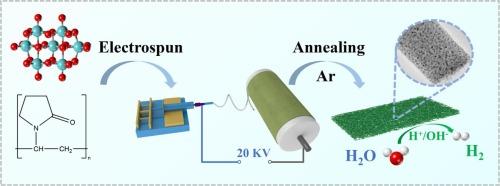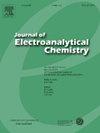Polyoxometalate-derived anti-aggregation MoC nanoparticles for efficient hydrogen evolution in basic and acidic media
IF 4.1
3区 化学
Q1 CHEMISTRY, ANALYTICAL
引用次数: 0
Abstract
As a cost-effective alternative to Pt-based catalysts, molybdenum carbide (MoC) exhibits considerable potential for catalysing hydrogen evolution reaction (HER) in both alkaline water electrolyzers and proton exchange membrane water electrolyzers. However, achieving ampere-level current densities at low overpotentials remains challenging for MoC-based electrocatalysts. In this study, we utilized electrospinning technology followed by a subsequent heat treatment to successfully synthesize monodisperse MoC nanoparticles (approximately 4.3 nm) embedded in carbon nanofibers. The resultant self-supporting one-dimensional molybdenum carbide@nitrogen-doped carbon nanofiber (MoC-A@NCNF), prepared with polyoxometalate anion (POM) and polyvinylpyrrolidone (PVP), exhibits excellent anti-aggregation behavior. Benefiting from its high specific surface area and one-dimensional conductive network structure, the MoC-A@NCNF displays outstanding hydrogen evolution reaction (HER) performance in both 1 M KOH and 0.5 M H2SO4, achieving overpotentials of 491 mV and 568 mV at a current density of 1 A cm−2, respectively. Furthermore, it exhibits exceptional electrochemical stability during prolonged HER testing under both acidic and alkaline conditions.

用于在碱性和酸性介质中高效氢气进化的聚氧化金属衍生抗聚集 MoC 纳米粒子
碳化钼(MoC)作为铂基催化剂的一种具有成本效益的替代品,在碱性水电解槽和质子交换膜水电解槽中催化氢进化反应(HER)方面具有相当大的潜力。然而,对于基于碳化钼的电催化剂来说,在低过电位下实现安培级的电流密度仍然具有挑战性。在本研究中,我们利用电纺丝技术,随后进行热处理,成功合成了嵌入碳纳米纤维的单分散 MoC 纳米颗粒(约 4.3 nm)。利用聚氧化金属阴离子(POM)和聚乙烯吡咯烷酮(PVP)制备的自支撑一维碳化钼@氮掺杂碳纳米纤维(MoC-A@NCNF)具有优异的抗聚集性能。得益于其高比表面积和一维导电网络结构,MoC-A@NCNF 在 1 M KOH 和 0.5 M H2SO4 中均表现出卓越的氢进化反应(HER)性能,在电流密度为 1 A cm-2 时,过电位分别达到 491 mV 和 568 mV。此外,在酸性和碱性条件下进行长时间的 HER 测试时,它还表现出卓越的电化学稳定性。
本文章由计算机程序翻译,如有差异,请以英文原文为准。
求助全文
约1分钟内获得全文
求助全文
来源期刊
CiteScore
7.80
自引率
6.70%
发文量
912
审稿时长
2.4 months
期刊介绍:
The Journal of Electroanalytical Chemistry is the foremost international journal devoted to the interdisciplinary subject of electrochemistry in all its aspects, theoretical as well as applied.
Electrochemistry is a wide ranging area that is in a state of continuous evolution. Rather than compiling a long list of topics covered by the Journal, the editors would like to draw particular attention to the key issues of novelty, topicality and quality. Papers should present new and interesting electrochemical science in a way that is accessible to the reader. The presentation and discussion should be at a level that is consistent with the international status of the Journal. Reports describing the application of well-established techniques to problems that are essentially technical will not be accepted. Similarly, papers that report observations but fail to provide adequate interpretation will be rejected by the Editors. Papers dealing with technical electrochemistry should be submitted to other specialist journals unless the authors can show that their work provides substantially new insights into electrochemical processes.

 求助内容:
求助内容: 应助结果提醒方式:
应助结果提醒方式:


